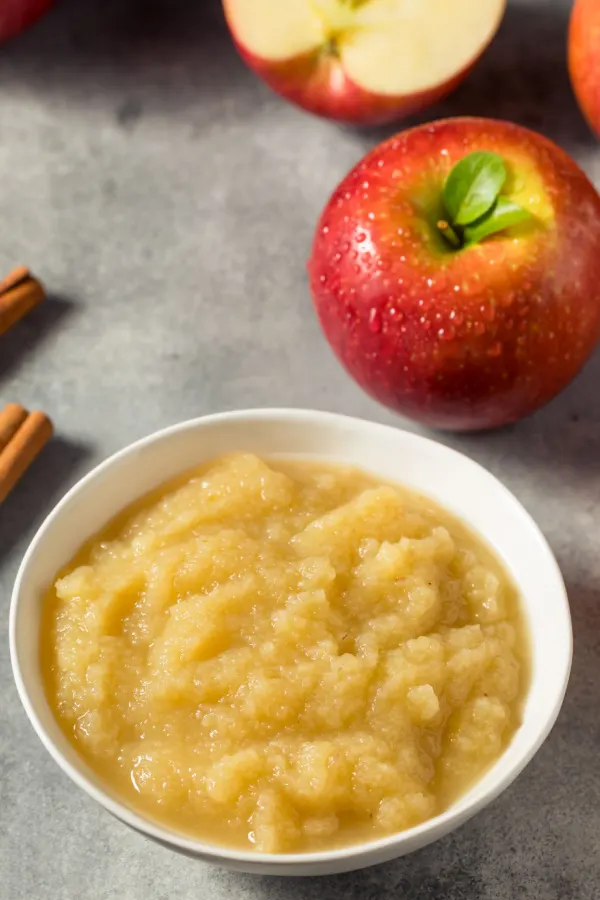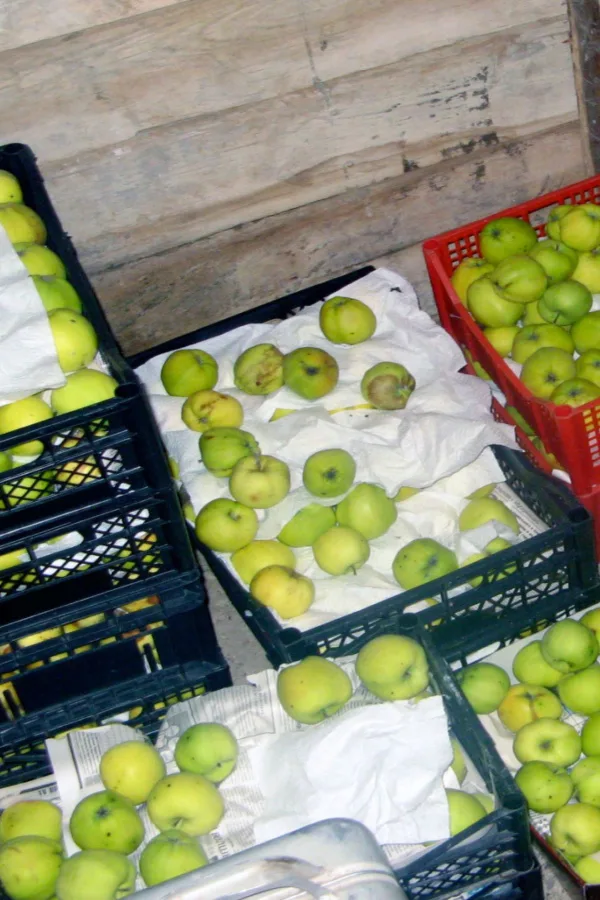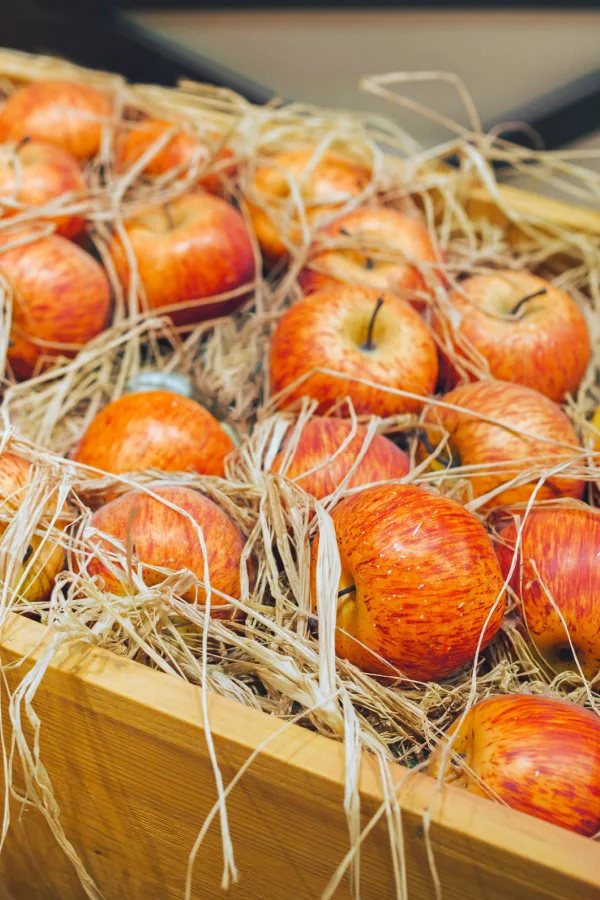Looking for simple tips on how to store apples for long-term use? By following a few steps, you can enjoy the flavor and texture of fresh picked apples long into the winter months!
Autumn is the perfect time to stock up on your favorite varieties of freshly picked apples. From the local Farmer’s market to “you-pick” farms, you can find great deals on buying apples in bulk during the fall months.
After you’ve filled your freezer or pantry with homemade applesauce, apple butter, or apple pie filling, you still may find yourself with leftover apples. Believe it or not, you can actually store those apples and they will last for several months.

Even if you don’t have a root cellar, you can still store apples for long-term use. As long as a few important steps are taken, you will get that same bright apple flavor and crispness in the winter that you get in the fall from just-picked apples.
Storing Apples For Short-Term Use
The best methods for storing apples will depend on how soon you plan to use them. If you are going to use them within a week, it’s fine to leave them on the countertop.
Just avoid placing them near other fruits and vegetables. Apples produce ethylene gas, which will speed up the ripening of other fruit.
For short-term storage that is slightly longer than one week, the best place for apples is in your crisper drawer. Most varieties can last for up to six weeks in refrigerator.
Apples prefer colder temperatures that are close to but not below freezing. They also enjoy a high level of humidity, which is why the crisper drawer in a refrigerator is a perfect place.
However, if you have a few apples that are starting to get soft, there is no need to throw them out. Use those apples to make applesauce or other cooked apple recipes.
But what do you do for long-term storage options when you have a surplus of apples?

How To Store Apples Long-Term
Choosing The Right Apples
To begin with, some varieties of apples can be stored for longer than others. To have the best success with long-term storage, choose varieties that store well. Sweeter varieties like Golden Delicious apples are softer and aren’t able to be stored for as long.
Instead, choose varieties like Braeburn, Fuji, Gold Rush, Granny Smith, Honeycrisp, Jonathan, McIntosh Pink Lady, Rome, and Winesap. These choices can last 6 months or more thanks in part to being tart, crisp, and having thicker skins.
In addition to the type of apple you are storing, you also need to be picky about the appearance of the apple. You want to pick apples that are blemish-free without bruises, cuts, or insect damage.
If apples are already damaged, they will quickly go bad and can actually ruin an entire batch of apples. Use these imperfect apples for fresh eating in the near future or for turning into applesauce, apple butter, or something similar. (See, “How To Can Applesauce – A Great Way To Preserve Apples“
Avoid using apples from the grocery store for long-term storage. For the most part, these apples have already been stored for a long time, which decreases the length of time you can store them in your home.
Protecting The Apples
For best results, don’t allow the apples to touch each other while in long-term storage. Keeping each apple separate also helps to prevent them from coming into direct contact with a spoiled apple.
Wrap each apple in a thin layer of newspaper. Stick to the black and white print and avoid using the colored, shiny inserts that often come inside newspapers.
You can also use butcher paper, brown paper bags, or paper towels to individually wrap the apples. The main goal is to prevent the apples from directly touching one another.
If wrapping isn’t an option, you can layer apples in boxes using new and clean straw, sawdust, or even sand to prevent the apples from touching. It is best to store them 1 inch apart from each other when using these methods.
Boxing Up The Apples
The best storage container for your wrapped apples is a small or medium-sized cardboard box. Avoid storing the fruit in large boxes.
Because you will need to check the apples for potential spoilage at least once a week it is easier to check a few small boxes rather than one large container for damaged apples. In addition, this lessens the chance that one spoiling apple from ruining batch.
If needed, you can lightly mist the apples with water while they are still wrapped in newspapers or in straw. This helps to increase humidity levels and keep the apples fresher for longer.
You can also store the fruit in wooden boxes rather than in a cardboard box. If purchasing wooden boxes, look for stackable options that will help you save on floor space. (Affiliate Product Link: Wooden Storage Cube)
Store the same apple varieties together since different apples ripen at different times. In addition, not all apples store for the same length of time. Also, keep smaller apples at the bottom of the boxes since larger apples tend to ripen quicker.
Picking The Storage Location
It’s now time to put your apples in the perfect long-term storage location. The ideal temperature for storing apples is around 32º Fahrenheit and about 90% humidity. Anything below 30ºF and the apples will freeze. Anything above 40ºF and the apples will ripen too quickly.
The best storage location is a root cellar. These old-fashioned spots within many older homes are the perfect spot for keeping garden and orchard goods like apples, potatoes, onions, and garlic for months.
Unfortunately, many homes nowadays no longer have root cellars. But most homes still have great alternatives to root cellars that mimic similar conditions. The main goal is to find a spot that is dark, cool, and has high humidity levels.

One of the best options is an unheated basement. Basements typically have higher humidity levels and tend to be on the cooler side. Even if your basement is heated, close some of the vents to cool down the space and use a humidifier near your storage spot.
Another alternative is an unheated garage or shed as long as the temperatures don’t drop below freezing. Even a cooler closet or storage room within your home can be an excellent choice for storing apples for long term.
No matter where you choose to store the apples, be sure to check them weekly. Remove any that are starting to soften or spoil and use those immediately.
By following these simple tips, you will be able to enjoy those fall-picked or purchased apples long into the cold winter months!
Enjoy!
Mary and Jim

Jim and Mary Competti have been writing gardening, DIY and recipe articles and books for over 15 years from their 46 acre Ohio farm. The two are frequent speakers on all things gardening and love to travel in their spare time.
As always, feel free to email us at thefarm@owgarden.com with comments, questions, or to simply say hello! You can sign up for our free email list in the subscribe now box in the middle of this article. Follow us on Facebook here : OWG Facebook. This article may contain affiliate links.


